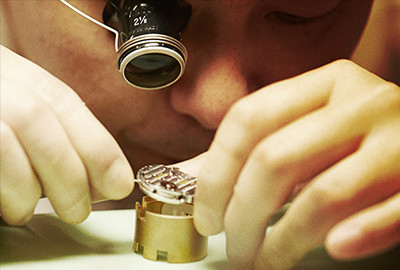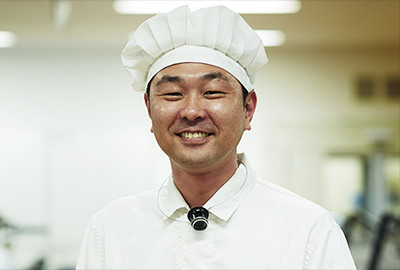Around 2000, I think. I came over to Shizuku-ishi when the quartz watch line I was in charge of was transferred. From the time I joined Seiko, I knew about Grand Seiko as a high-quality mechanical watch and I always wanted to try my hand at it. When I was actually transferred to the Studio I felt very proud.
 +
+
For about six months I worked on the process of lubricating parts with oil. The work setting was different from what I had been used to in producing quartz watches, and I had a difficult time at first. Later I was put in charge of hairspring adjustment, where I continue to work.
Yes it is. Most people can adjust other parts if given enough time, but few are able to adjust the hairspring.
Grand Seiko is well known for having particularly strict standards. I am in charge of readjustment when those criteria are not met.
If it’s a matter of minor flaws that cause the part to fail inspection, it is easy to make adjustments. But in some cases, even if the criteria are met, the watch may run slightly fast, for example. I make adjustments while keeping in mind the conditions in which the watch will be worn.
 +
+
Naturally dexterity—being good with one's hands—is a great advantage, but actually the eyes, especially kinetic vision, are critical.
When adjusting the hairspring you have to watch the movement under a microscope and observe where any eccentricity lies. This type of work is not so much about doing repetitive tasks, it’s mostly about quickly figuring out what is wrong and working efficiently. The job is suitable for creative thinkers with a desire to produce the highest quality.
I first make adjustments in the balance area and escapement. Then adjust the gearing of the pallet fork and escape wheel and the amount of shake in each part (unsteadiness in the gear axle, etc.). The balance and MEMS-produced pallet fork and escape wheel have a particularly significant effect on the watch overall, so I take great care here to improve the accuracy by readjusting the balance on the parts.
Yes, but to be honest you can't learn enough just during working hours. You can learn the processes from your superiors in the studio, but you have to learn horology on your own. In my case, I study horology to enter competitions or earn qualifications and then use that experience in my work. It's a constant process of development.
 +
+
I have a Grade 1 Watch Repair Technical Expert classification and a Mechanical Watch IW Meister* from Iwate prefecture. I passed the IW Meister test in 2013 on my fourth attempt. Candidates must answer 250 written questions, perform a live chronograph examination, give an explanation of the problem to the customer, and make the necessary adjustment. It was very tough, but it was a title that I really wanted, so when I passed all I could think was, "Finally!" (laughs)
*Between 2006 and 2013, only two people earned Iwate prefecture's Mechanical Watch IW Meister title.
A mechanical watch works without electricity. It need only be wound and yet is off by only seconds per day. If a manual watch is not wound at the same time every day or if the wearer is not active enough, there will be deviation. A mechanical watch adapts to the lifestyle of its user. People love it because it feels alive and in sync with their own personal rhythms. I would say that is one of its biggest attractions.
First and foremost, I want to maintain the Grand Seiko brand. But just maintaining it is not enough. I want to work toward a level of craftsmanship and skill to rival the makers of the vintage V.F.A.(Very Fine Adjusted) models.
 +
+





















